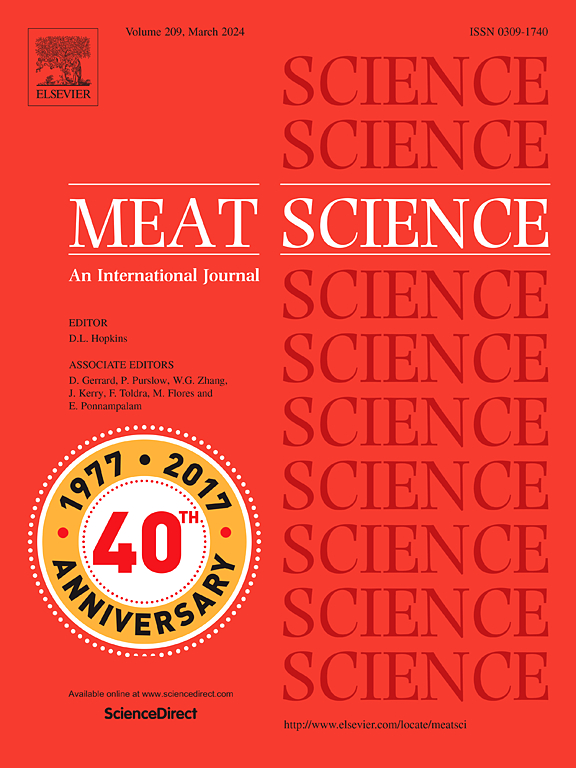Non-crystal freezing storage assisted by alternating electric field on fresh yak meat quality
IF 6.1
1区 农林科学
Q1 Agricultural and Biological Sciences
引用次数: 0
Abstract
Ice crystallization has been the main cause of the deterioration of frozen meat quality, because ice crystal expansion causes mechanical damage to the muscle tissue. Thus, in this study, an innovative non-crystal freezing (NCF) technology, which can achieve non-freezing at temperatures below the ice nucleation point (−4.5 °C for yak), was proposed, and corresponding equipment was designed to prolong the shelf life and increase the logistics distance of yak meat. The non-frozen stability and quality of yak meat with NCF were investigated and compared with those of traditional sub-frozen (−4.5 °C) and chilled (4 °C) yak meat. Results of thermal imaging and temperature curves indicate that ice nucleation and phase transition were observed in the −4.5 °C samples during 1–3 days, whereas the icing phenomenon was not found in the NCF samples during the entire 28-day storage period. The microstructure of the NCF samples was differed from that of the −4.5 °C samples, which avoided ice-induced freezing damage and maintained the original integrity. Compared with the −4.5 °C and 4 °C samples, the weight loss of the NCF samples was reduced by 5.33 %–6.94 % and 1.42 %–3.16 %, respectively. Microbial analysis and physicochemical results indicate that compared with 4 °C treatment, NCF extends the shelf life of yak meat by at least twice. NCF breaks down the line between chilling and freezing, combining advantages of low temperature and a non-freezing state, which makes the long-term storage and long-distance, cross-regional logistics of fresh yak meat possible.

交变电场辅助非晶冷冻对牦牛鲜肉品质的影响
冰晶化一直是冻肉品质恶化的主要原因,因为冰晶膨胀会对肌肉组织造成机械损伤。因此,本研究提出了一种创新的非晶冷冻(NCF)技术,该技术可以在冰核点以下(牦牛为- 4.5℃)的温度下实现不冻结,并设计了相应的设备,以延长牦牛肉的保质期,增加牦牛肉的物流距离。研究了NCF牦牛肉的非冷冻稳定性和品质,并与传统亚冷冻(- 4.5℃)和冷冻(4℃)牦牛肉进行了比较。热成像和温度曲线结果表明,在- 4.5°C条件下,样品在1 ~ 3 d内出现了冰核和相变,而NCF样品在整个28 d的贮存期内均未出现结冰现象。NCF样品的微观结构与−4.5°C的样品不同,避免了冰引起的冻结损伤,保持了原始的完整性。与−4.5°C和4°C样品相比,NCF样品的失重率分别降低了5.33% ~ 6.94%和1.42% ~ 3.16%。微生物学分析和理化分析结果表明,与4℃处理相比,NCF可使牦牛肉的保质期延长至少2倍。NCF打破了冷藏和冷冻之间的界限,结合了低温和非冷冻状态的优势,使新鲜牦牛肉的长期储存和远距离跨区域物流成为可能。
本文章由计算机程序翻译,如有差异,请以英文原文为准。
求助全文
约1分钟内获得全文
求助全文
来源期刊

Meat Science
工程技术-食品科技
CiteScore
12.60
自引率
9.90%
发文量
282
审稿时长
60 days
期刊介绍:
The aim of Meat Science is to serve as a suitable platform for the dissemination of interdisciplinary and international knowledge on all factors influencing the properties of meat. While the journal primarily focuses on the flesh of mammals, contributions related to poultry will be considered if they enhance the overall understanding of the relationship between muscle nature and meat quality post mortem. Additionally, papers on large birds (e.g., emus, ostriches) as well as wild-captured mammals and crocodiles will be welcomed.
 求助内容:
求助内容: 应助结果提醒方式:
应助结果提醒方式:


